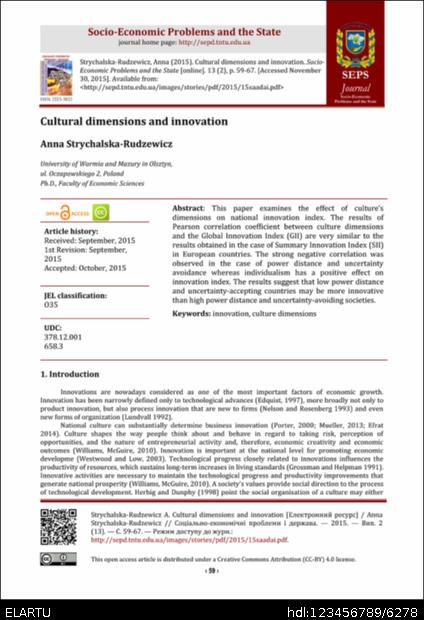Будь ласка, використовуйте цей ідентифікатор, щоб цитувати або посилатися на цей матеріал:
http://elartu.tntu.edu.ua/handle/123456789/6278

Повний запис метаданих
| Поле DC | Значення | Мова |
|---|---|---|
| dc.contributor.author | Strychalska-Rudzewicz, Anna | uk |
| dc.date.accessioned | 2015-12-02T16:21:08Z | - |
| dc.date.available | 2015-12-02T16:21:08Z | - |
| dc.date.created | 2015-11-24 | uk |
| dc.date.issued | 2015-11-24 | uk |
| dc.date.submitted | 2015-09 | uk |
| dc.identifier.citation | Strychalska-Rudzewicz A. Cultural dimensions and innovation [Електронний ресурс] / Anna Strychalska-Rudzewicz // Соціально-економічні проблеми і держава. — 2015. — Вип. 2 (13). — С. 59-67. — Режим доступу до журн.: http://sepd.tntu.edu.ua/images/stories/pdf/2015/15saadai.pdf. | uk |
| dc.identifier.issn | 2223-3822 | uk |
| dc.identifier.uri | http://elartu.tntu.edu.ua/handle/123456789/6278 | - |
| dc.description.abstract | This paper examines the effect of culture’s dimensions on national innovation index. The results of Pearson correlation coefficient between culture dimensions and the Global Innovation Index (GII) are very similar to the results obtained in the case of Summary Innovation Index (SII) in European countries. The strong negative correlation was observed in the case of power distance and uncertainty avoidance whereas individualism has a positive effect on innovation index. The results suggest that low power distance and uncertainty-accepting countries may be more innovative than high power distance and uncertainty-avoiding societies. | uk |
| dc.format.extent | 59-67 | uk |
| dc.language.iso | en | uk |
| dc.publisher | АСУ, ТНТУ | uk |
| dc.publisher | ASU, TNTU | uk |
| dc.relation.ispartof | Соціально-економічні проблеми і держава | uk |
| dc.relation.ispartof | Socio-Economic Problems and the State | uk |
| dc.subject | innovation | uk |
| dc.subject | culture dimensions | uk |
| dc.title | Cultural dimensions and innovation | uk |
| dc.type | Article | uk |
| dc.rights.holder | © Соціально-економічні проблеми і держава, 2015 | uk |
| dc.coverage.placename | Тернопіль | uk |
| dc.coverage.placename | Ternopil | uk |
| dc.subject.udc | 378.12.001 | uk |
| dc.subject.udc | 658.3 | uk |
| dc.relation.referencesen | Edquist, C., (1997), Systems of Innovations. Pinter, London. | uk |
| dc.relation.referencesen | Efrat, K. (2014), The direct and indirect impact of culture on innovation, Technovation 34, pp. 12–20. | uk |
| dc.relation.referencesen | Grossman, G., & Helpman, E. (1991), Innovation and growth in the global economy. Cambridge, MA: MIT Press. | uk |
| dc.relation.referencesen | Herbig, P., Dunphy, S. (1998), Culture and innovation. Cross Cultural Management 5 (4), 13–21. | uk |
| dc.relation.referencesen | Hofstede, G. (1980), Culture's Consequences: International Differences in Work-Related Values, London: Sage Publications. | uk |
| dc.relation.referencesen | Hryniewicz, J. (2004), Polityczny i kulturowy kontekst rozwoju gospodarczego, Warszawa, Wyd. Scholar. | uk |
| dc.relation.referencesen | Kołodko G. (2008), Wędrujący świat, Wydawnictwo Prószyński i S-ka, Warszawa. | uk |
| dc.relation.referencesen | Lundvall, B.A. (1992), National Systems of Innovation: Towards a Theory of Innovation and Interactive Learning. Pinter Publishers, London. | uk |
| dc.relation.referencesen | Mączyński, J., Jago A., Reber G., Böhnisch W. (1993), Styl kierowania ludźmi polskich, austriackich i amerykańskich menedżerów. Przegląd Psychologiczny 1, s. 65-80. | uk |
| dc.relation.referencesen | Mikuła B. Nasierowski W. (1995), Szkic do kultury organizacyjnej w Polsce. Humanizacja Pracy 4, s. 3-12. | uk |
| dc.relation.referencesen | Mueller, V., Rosenbusch, N., Bausch A., (2013), Success patterns of exploratory and exploitative innovation. Journal of Management, Vol. 39 No. 6, September, pp. 166-1636. | uk |
| dc.relation.referencesen | Nelson, R.R., Rosenberg, N. (1993), Technical innovation and national systems. In: Nelson, R.R. (Ed.), National Innovation Systems: A Comparative Analysis. Oxford University Press, New York, pp. 3–28. | uk |
| dc.relation.referencesen | Porter, M. E. (2000), Attitudes, values, beliefs, and the microeconomics of prosperity. In L. E. Harrison & S. P. Huntington (Eds.) (2000), Culture matters: How values shape human progress, New York: Basic Books, pp. 14–28. | uk |
| dc.relation.referencesen | Shane, S. (1993), Cultural influences on national rates of innovation, Journal of Business Venturing 8, pp. 59–73. | uk |
| dc.relation.referencesen | Sułkowski Ł. (2013), A 3D model and typology of organisational culture, Journal of Intercultural Management Vol. 5, No. 2, June, pp. 17–30. | uk |
| dc.relation.referencesen | Westwood, R., Low, D.R. (2003), The multicultural muse: culture, creativity and innovation. International Journal of Cross Cultural Management 3 (2), 235–259. | uk |
| dc.relation.referencesen | Williams L., McGuire S. (2010), Economic creativity and innovation implementation: the entrepreneurial drivers of growth? Evidence from 63 countries, Small Bus Econ (2010) 34:391–412. | uk |
| dc.identifier.citationen | Strychalska-Rudzewicz, Anna (2015). Cultural dimensions and innovation. Socio-Economic Problems and the State [online]. 13 (2), p. 59-67. [Accessed November 30, 2015]. Available from: <http://sepd.tntu.edu.ua/images/stories/pdf/2015/15saadai.pdf> | uk |
| dc.subject.jel | O35 | uk |
| dc.contributor.affiliation | University of Warmia and Mazury in Olsztyn, ul. Oczapowskiego 2, Poland, Ph.D., Faculty of Economic Sciences | uk |
| Розташовується у зібраннях: | Журнал „Соціально-економічні проблеми і держава“, 2015, Випуск 2(13) | |
Файли цього матеріалу:
| Файл | Опис | Розмір | Формат | |
|---|---|---|---|---|
| 15saadai.pdf | 989,88 kB | Adobe PDF | Переглянути/відкрити | |
| 15saadai.djvu | 950,28 kB | DjVu | Переглянути/відкрити | |
| 15saadai__COVER.png | 398,06 kB | image/png | Переглянути/відкрити |
Усі матеріали в архіві електронних ресурсів захищені авторським правом, всі права збережені.